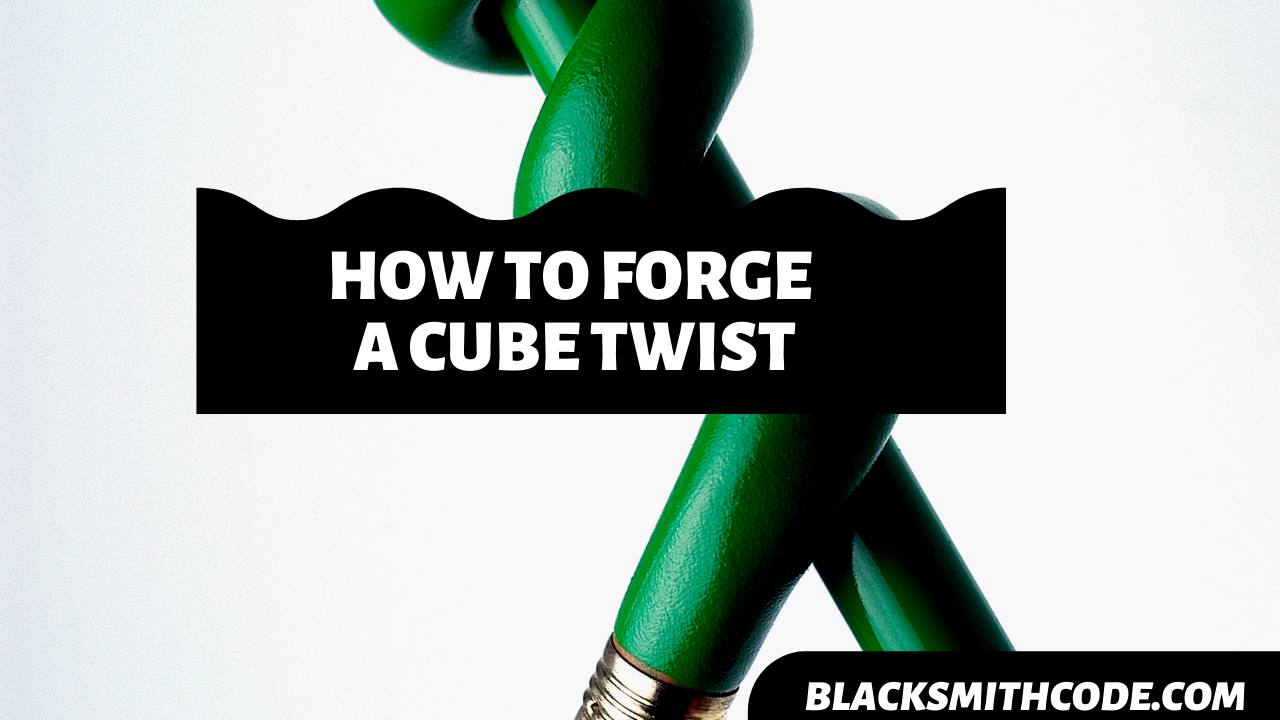Have you ever assessed how creative blacksmiths can get with metals? Cube twist is one of the most creative fabrications of blacksmiths. It takes up two distinct creativity concepts into one project. Learning how to forge a cube twist will certainly boost your blacksmithing rank.
If you are making a cube twist, you are indeed combining the skills involved in making twists, and the one involved in making metal cubes. The final outlook of this project usually makes it appear tedious.
Although the process might be a little bit technical, it is not as complicated as most onlookers imagine it to be, you can have a desirable output on the first try. The key is to understand the underlying techniques involved in the process.
The steps highlighted below can serve as a crucial guide to mitigate the stress you might have to face. However, it is essential to know the tools and essential materials you would need for the project.
Instructions on How to Forge a Cube Twist
Step 1: Get Your Materials
Arranging your workplace, getting your tools and materials ready for the process is the first step to forging any blacksmithing project. Get all the necessary tools and materials and make sure they are prepared for use.

Step 2: Mark the Slots
Marking the slot means measuring and marking the essential layout of the project. It is better to make jagged lines where you want to forge or make your twists. Measure and mark out every line you need.
Quick Steps
- Find the center of the square bar you are using.
- Make a mark along all the four sides.
- Make a 1-2” mark toward the end of the bar on all sides.
Pro Tip
The horizontal lines at the center of the bar are where you would make your grooves. At the same time, the vertical mark at the end of the bar helps you figure out the point to stop chiseling.

Step 3: Chisel Out the Lines
The main reason for chiseling out the lines is to make a more profound mark. The deeper the cut, the better you will be able to see it even after heating the steel.
Step 4: Heating
Now, it is time to start forging them in. Take the steel bar to the forge and heat it till it becomes malleable. However, it would help if you did not heat it to a point where you will no longer be able to trace the marks. This step is a vital transition step in learning how to forge a cube twist.

Step 5: Make the Cubes
Forming the cubes has two parts. The first part is measuring and marking out the shape of the cube, while the second part is cutting out the cubes.
Detailed Steps
- Choose your desirable cube size and spacing. You have to do a little bit of calculation to ensure that your marking and measurement are accurate. The cube size and spacing depend on the size of the bar you are using and what you intend to create.
- Remember, you are making a square, not a rectangle. Therefore, your measurement needs to be equal on all sides.
- Once you have made the accurate marks, go ahead and start building your cuts.
- Cut along the line of the cube that you marked. However, it would help if you were careful not to cut through the bar to the other sides.
- You can make use of a hacksaw. Alternatively, a good quality metal cutting blade can also serve the purpose in the absence of hacksaw. However, using a metal cutting blade is more time-consuming compared to using a hacksaw.
Step 6: Form the Twist
At this point, you must have been done with the cubes, now it is time to make the twists. This step is one of the most straightforward steps as much as it appears complicated from afar.
Detailed Steps
- Heat the steel to an orange color to make it very malleable. However, it is essential to note that you are not heating the entire bar. You are only raising the temperature to the length you chiseled, which serve as the part to be twisted.
- Clamp the non-heated end of the steel bar to a vise.
- Hold the other end of the steel with your jig. It is best to place the jig at a point that would allow you to make a natural twist.
- Start twisting the steel bar, gently and slowly. It is crucial to ensure that you are not bending the bar in the process.
- If you have a partner, he should help you brush off the scale. If not, you should brush it before taking it off the clamp.

Step 7: Finishing
The finishing is dependent on how you want the final output of your product to be. The most important thing is ensuring that the work has a perfect edge and an appealing outlook.
You can polish the cube twist to make it neater and more attractive. Give yourself a tap on the back if you get this on the first try.
FAQs on How to Forge a Cube Twist
Question
Can I forge cube twist from scrap metals?
You can forge cube twists from scrap metals as long as it has a regular rectangular shape. The shape of the material for making a cube twist is significant because of the measurement and precise cuts. The scrap material should also be strong enough to withstand the forging rigor of the project.
Question
How long does it take to form a cube twist?
Forging a cube twist is not time-consuming. You can form a cubic twist in about 1 hour or less. It depends on your experience, expertise, and how fast you can make your measurements and cuts.
Question
Is there a precise measurement for the cubes?
There is no standard measurement for what the size of the cube should be. The cube’s size depends on your choice and the length of rectangular steel you are using for the process. The size of the cubes should be proportional to the length of the bar to make it appealing.
Video on How to Forge a Cube Twist
Precautions and Warnings
- Ensure the use of safety and protective gears while forging a cube twist.
- Avoid handling hot steel with bare hands to avoid burns.
- Ensure that your workplace is well ventilated and not clumsy.




